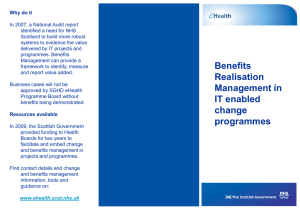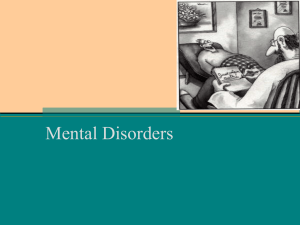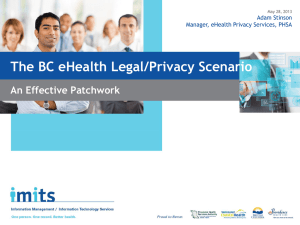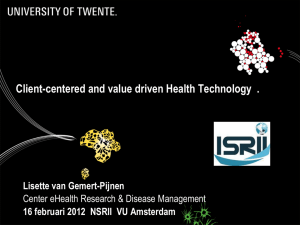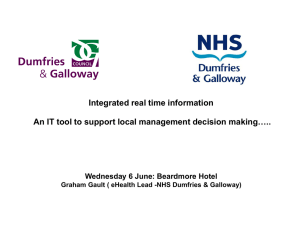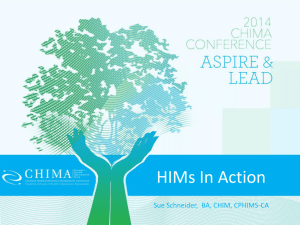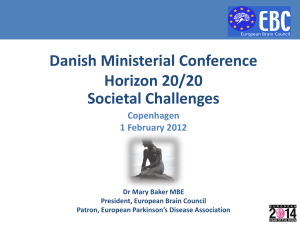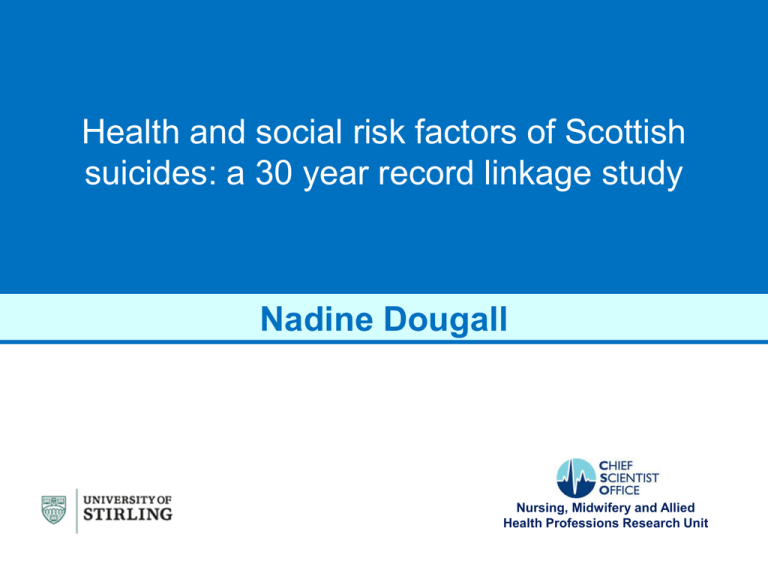
Health and social risk factors of Scottish
suicides: a 30 year record linkage study
Nadine Dougall
Nursing, Midwifery and Allied
Health Professions Research Unit
Scotland and electronic patient records (EPRs)
• Scotland a good laboratory for eHealth
research
– National Health Service (NHS), ‘free’ care at
point of access, wealth does not determine
access to healthcare
– Community Health Index (CHI) number a
unique patient identifier introduced in 1970’s
(~10M records)
– CHI full coverage since 1988, in widespread
use secondary and primary care
– 1989: creation of permanently linked national
datasets.
Scotland and electronic patient records (EPRs)
• Scotland a good laboratory for eHealth
research
– one of a handful of countries with indexed electronic
health records spanning decades
• Scottish record linkage system (SHIP; SHIS-R)
• Oxford record linkage system
• Rochester epidemiology project
• Manitoba Population Health Information System
• Sweden, Denmark & Norway
• Wales (SAIL)
• British Columbia linked health database
• WA data linkage system
• Taiwan
Scotland and electronic patient records (EPRs)
Definition of e-Health
Combined use of electronic communication and
information technology in the health sector?
Data linkage systems as research
infrastructure
“Each person in the world creates a Book of
Life. This Book starts with birth and ends with
death. Its pages are made of the records of
the principal events in life. Record linkage is
the name given to the process of assembling
the pages of this Book into a volume”
(Dr Halbert Dunn, 1946)
Scotland and eHealth patient records
Electronic Patient Records
Secondary care (hospitals)
• All indexed records held nationally in
datasets called Scottish Morbidity Records
(SMRs)
• Some of the best health service data in the
world for quality, coverage and consistency
• Data controller is the National Health
Service Information Services Division (NHS
ISD)
• Access via governance and ethics
committees
Scotland and eHealth patient records
Electronic Patient Records
–Primary care (general practice)
• NHS ISD hold summary data for general practices
but not individual patient level data
• General practice surgeries use 2-3 different systems
to hold data, but all use CHI number
• Inter-related research from primary to secondary
care not straight-forwards but CHI numbering
facilitates linkage
• Resources e.g. Primary Care Clinical Informatics Unit
(PCCIU - Scotland), data >200 practices and ~1M
patients; RCGP data (UK)
National context - SHIP
Scottish Health Informatics Programme
• 3 year funding (WT, MRC & ESRC) to
deliver national solution for Scotlandwide research platform for e-Health
data linkage
• Consortia of Uni’s of Dundee,
Edinburgh, Glasgow, St.Andrews with
NHS ISD
• Led by Andrew Morris, HIC, Dundee
• Leads to new HIC/ EHIRCs bid “SHIP2”
National context - SHIS-R
Scottish Health Information Service for
Research (NHS ISD)
• SHIS-R provisions all national NHSScotland
routine datasets for research
– SMR, community prescriptions, SHeS etc
– Pilot trial: A&E, NHS24, SAS
• SHIS-R will provide single interface for
linkage with 3rd party research datasets
• Propose a national safe haven (Gyle)
• plus local safe havens supported by SAHSC
nodes (N3 gateway), mostly local data
Scottish Government & Census
• Census costs ~£60M, Census 2021 likely
scrapped
• Census alternative – derive equivalent
information from linked SG datasets
• 2 alternative models:
– ‘big’ national safehaven for Gov data
(preferred by GRO/NRS)
– Federated SHIP approach of lots of
dummy terminals with Citrix software
(N3 connection still an issue)
National context
SHIS-R, SHIP/ HIC
Evolved solutions as model of
proportionate governance
– Level of access to data determined by the sort
of data requested
– Citrix software on researcher pc, acts as
remote secure enclave and is remote
monitored. Similar model to SDS, ADLS
– Researcher remains on Campus, accesses data
held on server behind firewall (held on NHS
server if clinical data)
– Timescale for solution ~April 2012
HIC strategy for Forth Valley
FVHB data capture
• ‘East of Scotland’ region of collaboration
with Tayside/ Dundee & St.Andrews/ Fife
• For data management and safe havens
• Discussed regional data warehouse with
Medical Director Iain Wallace
• Similar to Tayside & Fife but for Forth
Valley data
• Prescribing, SMR, deaths, lab tests, SCIDC
• Gives researchers access to local data
DAMES eHealth research
DAta Management through E-social Science
(DAMES)
– Universities of Stirling, Glasgow, Manchester
– Inter-disciplinary e-Science research spanning
sociology, economics, public health and
computer science
– 8 programme themes, 3 utilising grid
technology
– deals with data on occupations, education,
ethnicity/migration, social care and e-Health
ESRC funded £1,280,000, CI: Dr Paul Lambert, UoS
www.dames.org.uk
DAMES eHealth research
Remit: explore new ways to link eHealth data and/or other data in
novel linkages
– Negotiated access with NHS ISD for
third party data linkage provider (NeSC)
to link & anonymise SMR datasets and
deaths data (GRO/NRS refused)
– Access approved to CHI-Census lookup
table held at GRO (via safe haven)
– Separate study using SHeS and BHPS
imputed values together in one analysis
DAMES eHealth research
eHealth topic area - suicide
– 781 suicides in Scotland in 2010, agestandardised rate of suicide at ~15/
100,000 of population
– Leading cause of mortality in young
people, with rates of suicide 3x higher
for men (~24/100,000 in 2008)
– Scotland has a higher overall suicide
rate than England & Wales (male rate
for England ~12/100,000 in 2008,
double that of Scotland
DAMES eHealth research
Aim
To explore as many individual level health
and socio-economic risk factors together
in an analysis assessing hospital
utilisation patterns
Study design
Retrospective cohort study using NHS
hospital episode data (SMRs) and NRS
deaths data
DAMES eHealth research
Research questions
• What differences exist in hospital
utilisation prior to death?
• By gender and other SE factors?
• By decade?
• By duration of stay in hospital?
• By physical ill-health or mental health
admissions?
DAMES eHealth research
Methods
• Permissions NHS PAC, CG, REC
• Eligibility criteria
– all deaths recorded as suicide* since
records were available 1981-2010
– Age 15y+ and no upper limit
• NHS ISD provided pseudonymised data
– Death records, SMR01(general
hospital), SMR02 (maternity) & SMR04
(mental health)
– Stored at UoS, linked datasets using
deterministic match-merge Stata v10
*as a result of intentional self-harm
DAMES eHealth research
Variable operationalisation - consistent
categories over time
Occupation
– NRS coded to SOC80 & SOC2000
– 1990-99 coded in non-standard way
– Obtained NRS coding framework and
recoded 1990-99 to SOC90
•Stata syntax available online
www.dames.org.uk
– Harmonised SOC80, SOC90 & SOC2000 to
CAMSIS scale scores, an indicator of social
advantage based upon occupations
DAMES eHealth research
Variable operationalisation
Hospital episode SMR data coded by ICD 9 & 10
ICD-9 ICD-10 cross-mapping diagnostic codes
ICD-9 ~13,5K numeric codes (1980-98)
ICD-10 expansion ~68K alphanumeric codes (‘99 to
date)
Solution: Clinical classification software to
aggregate & harmonise ICD catalogues
• CCS from the US Agency for Healthcare Research
and Quality. Used for statistical analysis of data
for financial and research purposes
• CCS syntax implemented in Stata, classified ICD9 & ICD-10 codes into 260 aggregated & clinically
homogenous CCS categories
DAMES eHealth research
Variables operationalised
•
•
•
•
•
Carstairs deprivation index (postcode at death)
RGSC (coded by RG, death certificate); NS-SEC
Health board of residence
Employment status
Severity of disease burden by hospital admission
– e.g. type of admission: I/P, O/P
– proxy: length of stay in hospital
Under consideration:
• Comorbidity weightings (e.g. Charlson,
Elixhauser, MACSS)
• Postcode sector - ‘GeoConvert’, service will match
on postcode e.g. urban/rural indicators
Not possible: Ethnicity & Migration
DAMES eHealth research
Summary data for the linked suicide cohort
1981-2010
All deaths recorded
All deaths with CHI number
All deaths no CHI number
M:F with CHI no.
16,475*
14,325 (87%)
2,150 (13%)
10,607 (74%): 3,718 (26%)
Individuals with CHI No. &
SMR hospital episodes
11,231
No. of SMR hospital episodes 85,278 records
for 11,231 with CHI No.
85,278 records with multiple diagnostic codings
*does not include undetermined deaths
Prior
admissions
data episodes
for suicide deaths
Summary
data
– hospital
by gender
(Percentages from 10607 males and 3718 females)
Prior records across all files
Prior records in SMR01
0
1
2
3
4
5-9
10 or more
0
1
2
3
4
5-9
10 or more
0
.05
.1
.15
.2
.25
0
Prior records in SMR02
.1
.2
.3
Prior records in SMR04
0
1
2
3
4
5-9
10 or more
0
1
2
3
4
5-9
10 or more
0
.2
.4
.6
.8
1
Male
0
.2
.4
.6
.8
Female
Data shows percent by gender from 14325 recorded suicide deaths with respective prior admissions data.
Summary data – SMR common ICD10 codes
Mental heath records in suicide data: Primary diagnosis ICD Chapter, by record type
66. Alcohol-related mental disorders
67. Substance-related mental disorders
68. Senility and organic mental disorders
69. Affective disorders
70. Schizophrenia and related disorders
71. Other psychoses
72. Anxiety; somatoform; dissociative; and personality disorders
73. Preadult disorders
74. Other mental conditions
260. E Codes: All (external causes of injury and poisoning)
l
ity
tal
ita
ath
n
n
p
r
e
e
s
e
D
o
at
R4-M
-H
M
0
1
M
0
S
02
SR
SR
SR
Source: Data from SMR linked file (1980-2010), 30725 out of total 81250 records coded into CCS.
CCS
code for primary
(most common
prior ICD10 admissions)
Summary
datadiagnosis
– ICD-10
main condition
codes
Cancer of breast
Other and unspecified benign neoplasm
Diabetes mellitus with complications
Alcohol-related mental disorders
Substance-related mental disorders
Affective disorders
Schizophrenia and related disorders
Other psychoses
Anxiety; somatoform; dissociative; and personality disorders
Other mental conditions
Epilepsy; convulsions
Cataract
Other nervous system disorders
Acute myocardial infarction
Coronary atherosclerosis and other heart disease
Nonspecific chest pain
Acute cerebrovascular disease
Other circulatory disease
Pneumonia (except that caused by tuberculosis or sexually transmitted disease)
Acute bronchitis
Chronic obstructive pulmonary disease and bronchiectasis
Asthma
Other upper respiratory disease
Disorders of teeth and jaw
Esophageal disorders
Gastritis and duodenitis
Abdominal hernia
Anal and rectal conditions
Biliary tract disease
Pancreatic disorders (not diabetes)
Gastrointestinal hemorrhage
Other gastrointestinal disorders
Calculus of urinary tract
Genitourinary symptoms and ill-defined conditions
Contraceptive and procreative management
Other complications of pregnancy
Other complications of birth; puerperium affecting management of mother
Skin and subcutaneous tissue infections
Other skin disorders
Spondylosis; intervertebral disc disorders; other back problems
Other connective tissue disease
Skull and face fractures
Fracture of upper limb
Fracture of lower limb
Other fractures
Crushing injury or internal injury
Open wounds of head; neck; and trunk
Open wounds of extremities
Superficial injury; contusion
Poisoning by psychotropic agents
Poisoning by other medications and drugs
Poisoning by nonmedicinal substances
Other injuries and conditions due to external causes
Syncope
Abdominal pain
Other aftercare
Other screening for suspected conditions (not mental disorders or infectious disease)
Residual codes; unclassified
0
500
1,000
1,500 2,000
mean of nccs1
2,500
DAMES eHealth research
Influences on prior diagnosis type for suicides
Occupational advantage by type of prior mental health diagnosis
rde
rs
Sc
hiz
op
hre
nia
/re
lat
ed
71
.O
the
72
rp
.A
sy
ch
nx
os
iet
es
y;
so
ma
tof
orm
;d
iss
oc
73
.
.P
rea
du
lt d
iso
74
rde
.O
rs
the
rm
en
tal
co
nd
26
itio
0.
ns
EC
od
es
:A
ll (
ex
ter
na
l)
70
.
Aff
ec
tiv
ed
iso
69
.
Se
nil
ity
an
d
lat
ed
68
.
67
.
org
an
ic
95% Quasi SE
Su
bs
tan
ce
-re
lat
ed
Alc
oh
olre
66
.
All
oth
er
Coefficient
Prior contacts with suicides 1980-2010. Graph shows differences in occupational advantage by
diagnosis (CCS category). It depicts regression coefficients predicting CAMSIS score with 'quasi standard errors'.
Additional controls for gender and year of birth. N~85k, of which 54k are 'all other'.
Socio-economic aspects of suicide completers, Scotland, 1981-2010
N (%)
Mean age
(SD)
% married
Area mean
Carstairs
(1991)
Mean
CAMSIS
(male scale)
% not in
work**
2000-2009
1990-1999
1981-1989
m
f
m
f
m
f
3381 (69%)
1499 (31%)
4487 (75%)
1457 (25%)
4244 (76%)
1343 (24%)
44.0 (17)
51.1* (17)
40.9 (16)
45.8* (18)
41.6 (15)
43.4* (16)
46.6
47.7
39.8
38.3
32.2
32.9
3.18
3.20
3.23
3.27
3.25
3.33
45.1
49.4*
42.6
47.9*
46.3
54.9*
6.7
33.4*
10.5
32.7*
19.4
35.1*
*Female value significantly different to male value at 95% threshold
** GROS category: “Students, independent means, no occupation, handicapped”
Women were significantly older at death than men, age gap narrowed with
each decade (female mean age decreased by each decade; women
sig.higher CAMSIS for all decades i.e. in socially advantaged positions
0
.2
.4
.6
.8
1
Figure 1: Proportion of recorded cases with previous hospital admissions,
by type of admission (for deaths occurring in 1991-1999 and 2000-2009)
15-19
20-24
25-29
30-34
35-39
40-44
45-49
50-54
55-59
60-64
65+
Age at death
Prev. hospital, 1991-1999
Maternity, 1991-1999
Prev. mental, 1991-1999
Prev. hospital, 2000-2009
Maternity, 2000-2009
Prev. mental, 2000-2009
Source: 10473 suicides, 1991-2009. Cases with no valid chi-number imputed to no previous hospital episode
DAMES eHealth research
Median duration of stay in hospital for all prior
hospital episodes (geometric mean in days)
All prior episodes, both genders
36 days
All M 30 M 25-49y 32 M 50-65+y
30
All F 55 F 25-49y 51 F 50-65+y
70
M:F advantaged job
M:F deprived area
M:F cohabiting
46:77 days
33:58 days
21:46
People spent less time in hospital if they were older men,
personally less affluent, cohabiting, living in more deprived
areas.
10537 suicides, 1991-2009
Scaling of episode type by total previous duration of stay(s) in hospital (used to
derive a scaling of episode type as ‘Visibility of MH problems to health service’)
1. No prior episodes
2. Physical health only
Male
3. Mental health diagnostic
4. Other
1. No prior episodes
2. Physical health only
Female
3. Mental health diagnostic
4. Other
0
20
40
60
Duration in HS
80
Median length of stay:
Physical health CCS 9 & 11 days for M & F respectively.
Mental health CCS codes 68 & 97 days for M&F
Other external causes of harm 14 & 20 days for M&F
10473 individuals with 11,531 prior hospital records.
100
DAMES eHealth research
Regression models predicting time in hospital
due to mental health problems
Outcome variable: broad diagnostic categories
of physical health, mental health, ‘other’
external causes or no prior episode
The most parsimonious model fit (R-square
0.066) with significant predictor variables*
Being female, single, in employment, having
relatively poor occupational attainment,
living deprived area
*t-statistic >or= 2.0 at 95% confidence limits)
10537 suicides, 1991-2009
Time between last previous discharge and death
SR02 admissions
Any type of admissions
0
0
2,000
5,000
4,000
SR04 admissions
10,000
0
0
200
5,000
400
10,000
SR01 admissions
Any time since 1981
Last yr
Last 10 yrs
Last mnth
Last 5 yrs
Suicides since 1991 with one or more previous health admissions, by time between death and discharge
2395 suicides happened within one month of discharge.
(4756 & 9281 within one year & at any time since 1981, respectively)
2395 suicides - many more for physical health than mental health episodes
THANK YOU
UoS: Paul Lambert, Margaret Maxwell, Alison Dawson
NeSC: Richard Sinnott, Susan McCafferty, John Watt
NHS ISD: Anthea Springbett, Carole Morris, David Clarke
NRS: Frank Dixon
Nadine Dougall
Senior Research Fellow
NMAHP Research Unit
Iris Murdoch Building
University of Stirling
nadine.dougall@stir.ac.uk
01786 466285
Delivering, supporting and promoting high quality research to improve health
Nursing, Midwifery and Allied
Health Professions Research Unit

